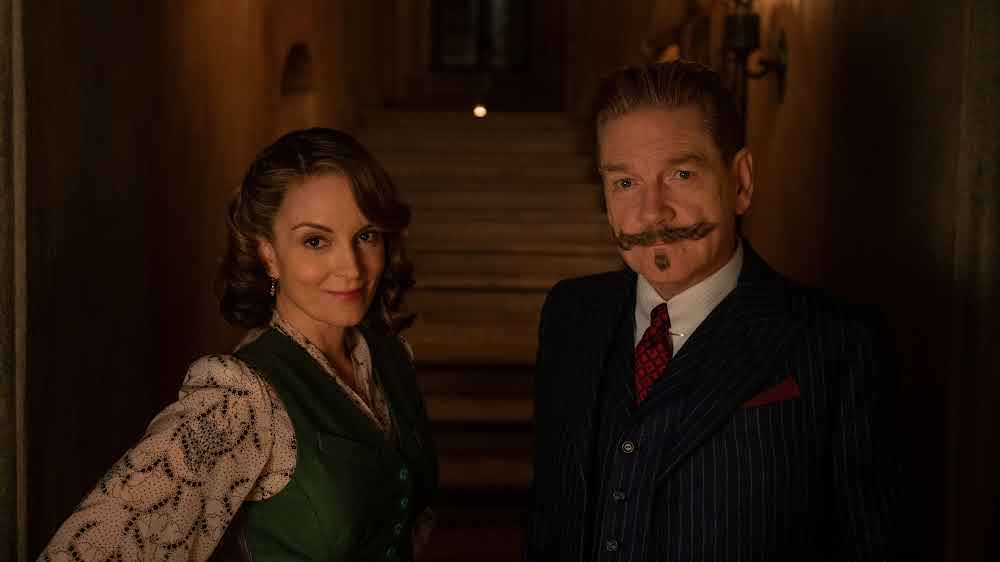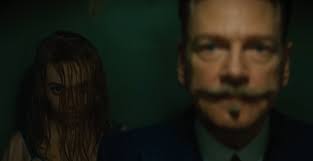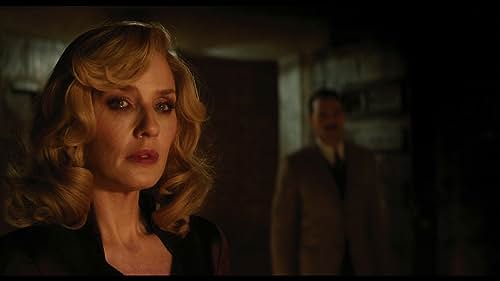What do a train and an old timey cruise ship having in common, other than being the settings for the first two Hercule Poirot movies starring and directed by Kenneth Branagh, based on the works of Agatha Christie? They’re both modes of transportation, which means they both have a certain inherent momentum that fuels the same in the narrative. A Haunting in Venice, the third Poirot movie following immediately on the heels of last year’s Death on the Nile (which took five years to follow Murder on the Orient Express), has no such mode of transportation at its centre – and has no such narrative momentum. Perhaps rushing it out so quickly is the only thing speedy about it.
Haunting is not made shoddily, as Branagh is an accomplished craftsman who always exceeds the minimum requirements of his job. However, the single location of a Venice palazzo does suggest the sort of COVID constraints we dealt with a couple years ago – even though the movie was shot only last October. The darkly lit single location is of course appropriate for what presents itself as a haunted house movie. It’s just that with nowhere for these characters to go – which, granted, is the basic conceit of almost every Agatha Christie novel – at least the place they’re trapped should be moving, or else it feels like a long 103 minutes.
It’s 1947, ten years and one world war removed from the events of Death on the Nile, and Hercule Poirot is now purportedly retired from investigating mysterious murders potentially committed by up to a dozen individuals. He’s passing his days with an uneasy peace in Venice. It’s uneasy not just because the famous detective is constantly approached by prospective clients with their own cases to solve, but because the things he’s seen have shaken a faith his scientific mind was already doing its best to squelch. In short, he wants to believe in a higher power, but no longer can – such a being would never be so cruel.
Poirot is approached by an old novelist friend, Ariadne Oliver (Tina Fey), with a case that could provide evidence of the existence of an afterlife – and therefore, that higher power Poirot is seeking. She wants Poirot to observe a medium, Joyce Reynolds (Michelle Yeoh), in order to determine what tricks she’s using to allegedly commune with the dead, because Oliver herself cannot figure out the angle. Reynolds is scheduled to perform a séance at a Halloween party in a palazzo owned by retired opera singer Rowena Drake (Kelly Reilly), with the hope of contacting the spirit of Drake’s daughter Alicia – who fell to her death from the palazzo a year before. (The title of Christie’s novel is actually Hallowe’en Party.)
Every time Poirot thinks he’s uncovered proof that Reynolds is a charlatan, he’s confronted with something unexplainable that shakes his core investigative techniques and everything he believes to be true. When fresh bodies begin turning up, he locks the other gathered guests inside the palazzo to interview each and try to divine whether the murderer is one of them – or indeed is of flesh and blood at all. Also featured among the ensemble are Jamie Dornan, Kyle Allen, Camille Cottin, Emma Laird and Riccardo Scamarcio.
Although murders are a part of every Christie adaptation, this is the first one Branagh has done that dabbles in murder’s other most likely genre: horror. It seems as though A Haunting in Venice wants to have something in common with the Conjuring movies and their ilk – even as we know there will always be a terrestrial explanation, something Christie’s work has in common with Sherlock Holmes and Scooby Doo. As mentioned earlier, Branagh is a skilled enough filmmaker to work these components into his film with reasonable effectiveness. One of the interesting aspects of the second half of Branagh’s career is his capability within genres that did not traditionally define him early on. Remember, this is the one-time foremost film adapter of the works of William Shakespeare.
Here, though, Branagh finds himself rubbing elbows with multiple film styles that are kind of old hat at this point. Even if Murder on the Orient Express can be credited with helping revive the ensemble whodunnit, that sort of film has gotten a lot of incarnations in the years since (see the recent works of Rian Johnson). Sprinkle in The Conjuring, now also way overexposed, and you have a film that doesn’t feel very fresh, even as it looks first rate. (When we do occasionally get outside the palazzo, really only at the beginning and the end, Branagh’s personal DP Haris Zambarloukos gives us breathtaking views of the city.)
Speaking of Johnson’s films, one thing that makes those movie sing is a lively cast who steal their every moment on screen. A Haunting in Venice is a big step backward from the previous two films in that regard. Those films were fuelled by the star power of actors like Penelope Cruz, Daisy Ridley, Johnny Depp, Gal Gadot and Annette Bening, but here you’re stuck here with Fey and a too-brief appearance by Yeoh. Without researching the financing of this film, its single location and mediocre star wattage suggest a studio trying to sneak in another hit on the cheap.
They might get away with it. A Haunting in Venice tends to be claustrophobic in ways that are more weaknesses than strengths, but it does serve up Christie’s typically clever plotting cleanly enough, ultimately satisfying the people who try to follow the clues more than frustrating them. The studio will sneak in another if they can; the most unsurprising thing about any character who claims they’re retired is that they end the movie very much back on the active roster. Whether our reaction as audiences justifies another sequel is another matter … though you can always continue to cut back on resources.
A Haunting in Venice is currently playing in cinemas.



